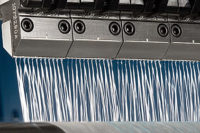Disposable Hygiene: One Core Adhesive Does Not Fit All
As core fluff in disposable hygiene products is decreased or eliminated, the role of adhesives becomes increasingly essential to core integrity.

Figure 1. Diaper core components.







In mature markets, disposable diaper and feminine hygiene products have reached market saturation. Since consumers of these products expect reliable absorption and no leakage, their purchase decisions are now based on other differentiating factors, such as scent and softness—but also thinness. Thinner products with less bulk, waste and store shelf space requirements are appealing for both consumers and retailers. While there are many ways to reduce the thickness of a diaper, the most impactful is reducing the fluff pulp amount. As the demand grows for thinner diapers with less pulp, maintaining the integrity of the absorbent core while reducing fluff percentage becomes more challenging.
As fluff pulp is reduced, the task of holding the core together and in place rests largely with the adhesive. But the same adhesive choice, amount and application used when the superabsorbent polymer (SAP) and fluff ratio is 50/50, will not perform as effectively when the SAP/fluff ratio is changed to 70/30 or an even a more disparate ratio.
In fact, there is no single global adhesive solution for all core designs and performance measures. Nor is this panacea even possible given the ever-changing range of design variations, substrates and test parameters. That’s why a holistic approach—one that takes into consideration all of the issues involved in a product’s makeup or system—is necessary to create an adhesive solution based on the final core design that will optimize core integrity performance.
The Challenges of “Thin”
The goal for many in the disposable hygiene industry is to produce a thinner diaper that looks like underwear. In order to successfully achieve this, the disposable product requires a non-bulky (or thin) core. To some, “thin core” means reduced core fluff. To others, it equates to fluff free.
When the amount of fluff is reduced in the core, SAP is increased. It’s important to note that a key function of fluff is keeping SAP in place. Hence, removing fluff minimizes the ability to control SAP positioning in the core and to control SAP gel blocking, potentially changing the entire absorbent system of a diaper. It also may change the overall shape and dimensions of the diaper, which will impact fit. When changing the core, alterations in the stretch engine or elastic legs (two other key adhesively bonded applications) may be required.
The Core as a System
The core of a diaper is a dynamic, complex composite of many individual components that must work together as a system in order to function properly. As shown in Figure 1, each component has specific tasks to fulfill in order for the core to enable the diaper to achieve its main goal: keep the wearer feeling dry and comfortable.
As with any dynamic system, when one component is altered, it can impact the performance of each of the other components. For optimal overall performance, producers and suppliers must look at the core system in a holistic manner. The absorbent core—that blend of SAP and fluff in the middle of the diaper or pad—is only one aspect of what performs the absorption function in the diaper.
To achieve thinner cores, a producer is likely to think first of changing the ratio of SAP and fluff (reducing fluff). With a holistic approach, the next step is to assess how that change will affect all the other components that contribute to the absorption distribution layer (ADL): the core wrap, topsheet material, adhesives, etc.
The Role of Adhesives
While suppliers of layer materials, films and nonwovens for backsheets and topsheets are making strides in adapting their products to meet the demand for thinner cores, adhesives are also undergoing innovative changes that enable disposable hygiene product producers to more effectively use these emerging material innovations. Adhesives can perform a number of functions in the core area. If a core wrap is used, adhesives can be added to seal the wrap and prevent SAP migration. They can also be used to bond the layers of the core: ADL to core and core to backsheet. The extent of adhesive use also depends on geographical location.
While some adhesives may not contribute directly to core or absorption (e.g., wetness indicators and elastic attachment adhesives), they do impact and contribute to the entire system. The system cannot work well, with good fit and liquid containment, without the reliable performance of adhesives throughout the product.
Core Integrity
The quality of core integrity is generally gauged by how well the core performs when the SAP fluff pad is wet. However, as we take a more holistic approach, we want to move beyond considering that core integrity is important only when the fluff is wet. We also need to learn how the core behaves when the wearer is moving because the core needs to remain in one piece.
Cracking and shifting allow leakage. Even if the core cracks or shifts while dry, the SAP powder may gather in one region instead of spreading evenly within the crotch section, so it won’t be able to perform properly when wet. Finally, it is important to confirm that the core can retain the fluid within the core wrap, therefore that this important part of the system is properly sealed. Figure 2 illustrates these three key aspects of core integrity.
Testing Core Performance
No single industry standard lab test method exists to measure core integrity or the stability of the fluff/SAP distribution within the diaper core. Today’s tests range from using simple tools to complex equipment, and from acquiring quantitative to qualitative results. Most of the market focuses on testing core integrity directly by exerting force on the diaper to observe for core cracking as a measure of how well the core stays in place within the diaper. The force is generally some type of mechanical spinning, shaking or swinging after the diaper is made wet for a specified length of time. While these tests may provide some measure of quantitative data, they do not reflect the realities of the abuse that the core endures before the insult. In addition, they often require some sort of cumbersome equipment.
Considering that, Bostik’s Nonwoven global business unit has created a comprehensive yet simple-to-implement test method to evaluate performance. The Conditioned Core Cracking Test recognizes the validity of shaking a core to evaluate its integrity, as well as testing when the core is wet. A new element is included as well: preconditioning and testing a dry core, or “conditioned core cracking.”
A “crack” is a separation in the core. With a core crack, a second insult will not be well absorbed. Instead, the liquid will go into the crack that has been created and likely leak out of the diaper. As part of the overall core integrity, it is important to evaluate bond strength in wet conditions to ensure that the core wrap stays properly sealed and is ready to overcome volume variations due to SAP swelling.
While core integrity plays a powerful role in absorption performance, good core integrity results don’t automatically equal good absorption performance. It is important to differentiate between core integrity tests and absorption performance. Absorption performance also must be closely evaluated as part of a holistic approach. To ensure performance, manufacturers must evaluate:
• Acquisition—how fast liquid can be absorbed under pressure
• Distribution—how well the entire core is utilized after acquisition
• Rewet—how effective is the core at keeping wetness away from the skin under pressure
• Wicking—how far can liquid be transported within the core
The Status of Fluff Free
For nearly the last decade, the topic of fluff-free diapers has been at the forefront of the trends and dynamics of the diaper market. Many large diaper manufacturers have described concepts around fluff-free cores and have patented intellectual property (IP). These patents are indicative of the main issues with a fluff-free core: increased movement of the SAP particles, and less diffusion of the liquid or less availability of absorbing capacity for multiple insults (gel blocking).
The crowded IP landscape reveals a variety of methods aimed at immobilizing SAP. Approaches identified include adhesive-bonded designs, alternate bonding method designs, pre-made core solutions (on a roll), absorbent ADLs, and many others.
In collaboration with BASF, Bostik has developed an approach that achieves the necessary SAP immobilization and fluid management results with an SAP and adhesive system. It addresses the issue of SAP movement and diffusion of fluids by creating discrete pockets of SAP on the core laminate. While there are only a small number of fluff-free designs on the market today, acceleration in the number of IP published and in the communication suggests that there is more to come.
Adhesive Choice is Key
As the thin core trend grows and spreads across the global market, it is critical that producers and suppliers adopt a holistic approach in answering the demand. Key to that is the role that adhesives play. In order to achieve the best results, producers need a variety of adhesive options to choose from. In the end, core design and performance expectations determine the adhesive that will generate best results for the entire core system.
For more information, contact the author at (414) 607-1258 or diane.toonen@bostik-us.com, or visit www.bostik-us.com.
Editor's note: All images courtesy of Bostik.
Fluff vs. SAP
Most cores on the market today contain about half fluff and half SAP. Reducing the amount of fluff to 30% or 40% will make a noticeably thinner product. With the current core-forming systems in use today, it’s possible that a ratio of 70% SAP to 30% fluff can be reached.
Machine suppliers are also offering new systems that achieve an 80% SAP:20% fluff ratio. But a SAP ratio of more than 80% cannot be achieved with the technology that is currently available to the broader market. Increasing the SAP ratio above that 80% mark requires overcoming that technology gap—the same gap that currently is inhibiting the creation of entirely fluff-free cores.
Looking for a reprint of this article?
From high-res PDFs to custom plaques, order your copy today!









